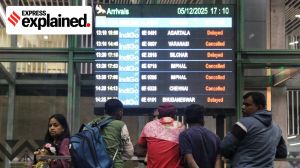India and Iran signed a 10-year contract on Monday for the operation of a terminal at the strategically important Chabahar port in Iran.

Union Minister for Shipping, Ports and Waterways Sarbananda Sonowal witnessed the signing of the contract between India Ports Global Ltd (IPGL) and Ports & Maritime Organisation of Iran (PMO) in Tehran.
IPGL will invest approximately $120 million to equip and operate the port for the duration of the contract, and the two sides will further extend their cooperation in Chabahar thereafter. India has also offered a credit window in rupees equivalent to $250 million for mutually identified projects to improve infrastructure related to the port.
Slow start to project
Modern Chabahar came into being in the 1970s, and Tehran realised the strategic importance of the port during the Iran-Iraq war of the 1980s.
In 2002, Hassan Rouhani, who was Iran’s National Security Advisor under President Syed Mohammad Khatami at the time, held discussions with his Indian counterpart Brajesh Mishra on developing the port, located 72 km west of Pakistan’s Gwadar port.
In January 2003, President Khatami and then Prime Minister Atal Bihari Vajpayee signed off on an ambitious roadmap of strategic cooperation. Among the key projects the two countries agreed on was Chabahar, which held the potential to link South Asia with the Persian Gulf, Afghanistan, Central Asia, and Europe.
Story continues below this ad
The New Delhi Declaration signed by the two leaders recognised that the countries’ “growing strategic convergence need[ed] to be underpinned with a strong economic relationship”. For India, Chabahar held immense strategic and economic significance, as it provided a route to reach Afghanistan — land access to which had been blocked by a hostile Pakistan.
But the ambitious timelines for the project were undone by India’s growing relationship with the United States under President George W Bush. The US, which declared Iran as one of the “axis of evil” along with Iraq and North Korea, pushed New Delhi to abandon its strategic relationship with Tehran, and the Chabahar project became a casualty.
Progress after 2015
While India spent about $100 million to construct a 218-km road from Delaram in western Afghanistan to Zaranj on the Iran-Afghan border to link with Chabahar, the port project itself progressed at a glacial pace. But things started to change in 2015 after talks between Iran and the P-5+1 bore fruit.
About three weeks after Iran and the world powers announced their framework deal on April 2, 2015, and committed to finalising a comprehensive deal by the end of June, then Afghan President Ashraf Ghani visited India and stressed the importance of the Chabahar port.
Story continues below this ad
During Ghani’s April 27-29, 2015 visit, he and Prime Minister Narendra Modi agreed to work closely with Iran to make the port project a reality, and to develop it as a viable gateway to Afghanistan and Central Asia. They agreed that routes additional to the existing ones will provide a major impetus to Afghanistan’s economic reconstruction efforts.
Over the next one year, coordination between the three countries led to the signing of a Trilateral Agreement to establish the International Transport and Transit Corridor in May 2016, when Prime Minister Modi visited Iran. Thereafter, India’s Shipping Ministry worked at a brisk pace to develop the project.
The attitude of the Donald Trump administration towards Iran complicated matters after 2017, but South Block appeared determined to stay the course. New Delhi managed to get a waiver from the US for the Chabahar project, citing access to Afghanistan as a reason.
India’s approach also stemmed from the fact that China was aggressively pursuing President Xi Jinping’s ambitious Belt and Road Initiative for massive infrastructure development across large parts of Asia and Africa.
Story continues below this ad
Developments in recent years
India has so far supplied six mobile harbour cranes (two of 140-tonne and four of 100-tonne capacity) and other equipment worth $25 million.
IPGL has been operating Chabahar port through its wholly owned subsidiary, India Ports Global Chabahar Free Zone (IPGCFZ), since December 24, 2018. The port has handled more than 90,000 twenty-foot-equivalent units (TEUs) of container traffic and more than 8.4 million metric tonnes (MMT) of bulk and general cargo since then.
The port has also facilitated the supply of humanitarian assistance, especially during the Covid-19 pandemic. Till date, a total of 2.5 million tonnes of wheat and 2,000 tonnes of pulses have been trans-shipped from India to Afghanistan through Chabahar port. In 2021, India supplied 40,000 litres of the environment friendly pesticide (malathion) through the port to Iran to fight locust attacks.
In August 2023, Prime Minister Modi met with President Ebrahim Raisi in Johannesburg on the sidelines of the BRICS Summit, and discussed the pending long-term contract on Chabahar. The two leaders gave a clear political direction to finalise and sign the long-term contract.
Story continues below this ad
Chabahar and INSTC
With the operationalisation of the long-term investment, Chabahar could potentially become an important hub to connect India with the landlocked countries of Central Asia and Afghanistan. However, to better realise its commercial and strategic potential, the development of the port must be integrated with the larger connectivity project of the International North South Transport Corridor (INSTC).
The INSTC, which was initiated by Russia, India, and Iran, is a multi-modal transportation route envisaged to link the Indian Ocean and Persian Gulf to the Caspian Sea via Iran, and onward to northern Europe via St Petersburg in Russia.
The INSTC envisages the movement of goods from Mumbai to Bandar Abbas in Iran by sea; from Bandar Abbas to Bandar-e-Anzali, an Iranian port on the Caspian Sea, by road; from Bandar-e-Anzali to Astrakhan, a Caspian port in the Russian Federation by ship across the Caspian Sea; and onward to other parts of the Russian Federation and Europe by rail.
Phunchok Stobdan, a senior fellow at the Institute for Defence Studies and Analyses (IDSA) and a former Indian Ambassador to Kyrgyzstan, wrote in an IDSA issue brief in June 2017 that “INSTC and Chabahar Port will complement each other for optimising Indian connectivity with Russia and Eurasia”. However, the war in Ukraine and the destruction of Europe’s relationship with Russia has since complicated the future of this project.








































